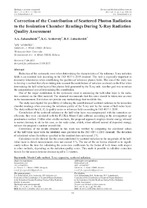| dc.contributor.author | Zaharadniuk, A. A. | |
| dc.contributor.author | Senkovsky, K. G. | |
| dc.contributor.author | Lukashevich, R. V. | |
| dc.coverage.spatial | Минск | ru |
| dc.date.accessioned | 2022-11-11T12:14:10Z | |
| dc.date.available | 2022-11-11T12:14:10Z | |
| dc.date.issued | 2022 | |
| dc.identifier.citation | Zaharadniuk, A. A. Correction of the Contribution of Scattered Photon Radiation to the Ionization Chamber Readings During X-Ray Radiation Quality Assessment = Коррекция вклада рассеянного фотонного излучения в показания ионизационной камеры при оценке качества рентгеновского излучения / A. A. Zaharadniuk, K. G. Senkovsky, R. V. Lukashevich // Приборы и методы измерений. – 2022. – Т. 13, № 3. – С. 180-188. | ru |
| dc.identifier.uri | https://rep.bntu.by/handle/data/122372 | |
| dc.description.abstract | Reduction of the systematic error when determining the characteristics of the reference X-ray radiation fields is an essential task according to the ISO 4037-1:2019 standard. This task is especially important in dosimetry laboratories when establishing the qualities of reference photon fields. The aim of the study was to develop a method that allows taking into account the contribution of radiation scattered on the filter when determining the half-value layer of the photon field generated by the X-ray unit. Another goal was to reduce the computational cost of determining this contribution. One of the major contributors to the systematic error in measuring the half-value layer is the radiation scattered on the filter material. The standard recommends that this error should be taken into account in the measurement. But it does not provide any methodology that would do this. The study investigated the possibility of reducing the contribution of scattered radiation to the ionization chamber readings when assessing the radiation quality of the X-ray unit by the means of half-value layer. The study utilized the (N, H, L) quality series as reference fields according to ISO 4037-1:2019. Contribution of the scattered radiation to the half-value layer was compensated with the correction coefficients; they were calculated with the FLUKA Monte Carlo software according to the zero-aperture approximation method. Unlike other similar methods, the proposed approach employs kinetic energy released to matter (kerma), to air in this case, as the main value, which, when utilized instead of deposited energy, reduces the program’s runtime several fold. Correctness of the results obtained in this work was verified by comparing the calculated values of the half-value layer with the tabulated ones provided in the ISO 4037-1:2019 standard. The deviation of calculated values from those specified in the standard does not exceed 2 %. Calculation results showed that the error contributed by scattered radiation to the magnitude of the halfvalue layer in direct measurements does not exceed 5 %. The use of the air kerma allowed us to significantly reduce the time for calculating the correction coefficients by the factor of 6–16 times with respect to other methods, depending on the radiation quality series. This made it possible to calculate correction factors for the source-detector distance equal to 2.5 meters. | ru |
| dc.language.iso | en | ru |
| dc.publisher | БНТУ | ru |
| dc.title | Correction of the Contribution of Scattered Photon Radiation to the Ionization Chamber Readings During X-Ray Radiation Quality Assessment | ru |
| dc.title.alternative | Коррекция вклада рассеянного фотонного излучения в показания ионизационной камеры при оценке качества рентгеновского излучения | ru |
| dc.type | Article | ru |
| dc.identifier.doi | 10.21122/2220-9506-2022-13-3-180-188 | |
| local.description.annotation | Уменьшение систематической погрешности при определении характеристик эталонных полей рентгеновского излучения в соответствии со стандартом ISO 4037-1:2019 является актуальной задачей при установлении качеств излучения в дозиметрических лабораториях. Целью работы являлась разработка метода, позволяющего учесть вклад излучения, рассеянного на фильтре, при определении слоя половинного ослабления поля фотонного излучения, генерируемого рентгеновской установкой, а также уменьшить затраты на определение этого вклада. Одним из основных факторов, который вносит систематическую погрешность при измерении слоя половинного ослабления, является излучение, рассеянное на материале фильтра. Стандарт рекомендует учёт этой погрешности при проведении измерений, однако не содержит методики, которая позволила бы это сделать. В работе исследовалась возможность уменьшения вклада рассеянного излучения в отклик ионизационной камеры при оценке характеристик полей излучения рентгеновской установки с помощью измерения слоёв половинного ослабления для N-серии, L-серии и H-серии качеств рентгеновского излучения согласно стандарту ISO 4037-1:2019. Компенсация вклада рассеянного излучения в результаты измерений производилась путём применения корректирующих коэффициентов. Расчёт коэффициентов производился методом нулевой апертуры, реализованным в Монте-Карло программе FLUKA. Основным отличием метода, предложенного в данной работе, является выбор воздушной кермы в качестве расчётной величины отклика компьютерной модели ионизационной камеры на воздействие фотонного излучения. Корректность результатов, полученных в данной работе, проверялась сопоставлением расчётных значений слоёв половинного ослабления с табличными значениями, приведёнными в стандарте ISO 4037-1:2019. Отклонение расчётных значений от указанных в стандарте не превышает 2 %. Установлено, что погрешность, вносимая рассеянным излучением в величину слоя половинного ослабления при прямых измерениях, не превышает 5 %. Использование воздушной кермы позволило существенно сократить время расчёта коэффициентов коррекции (относительно других методов, где в качестве отклика модели ионизационной камеры используется поглощённая энергия) в 6–16 раз в зависимости от серии качества излучения. Это позволило произвести расчёт поправочных коэффициентов для расстояния источник–детектор, равного 2,5 м. | ru |

